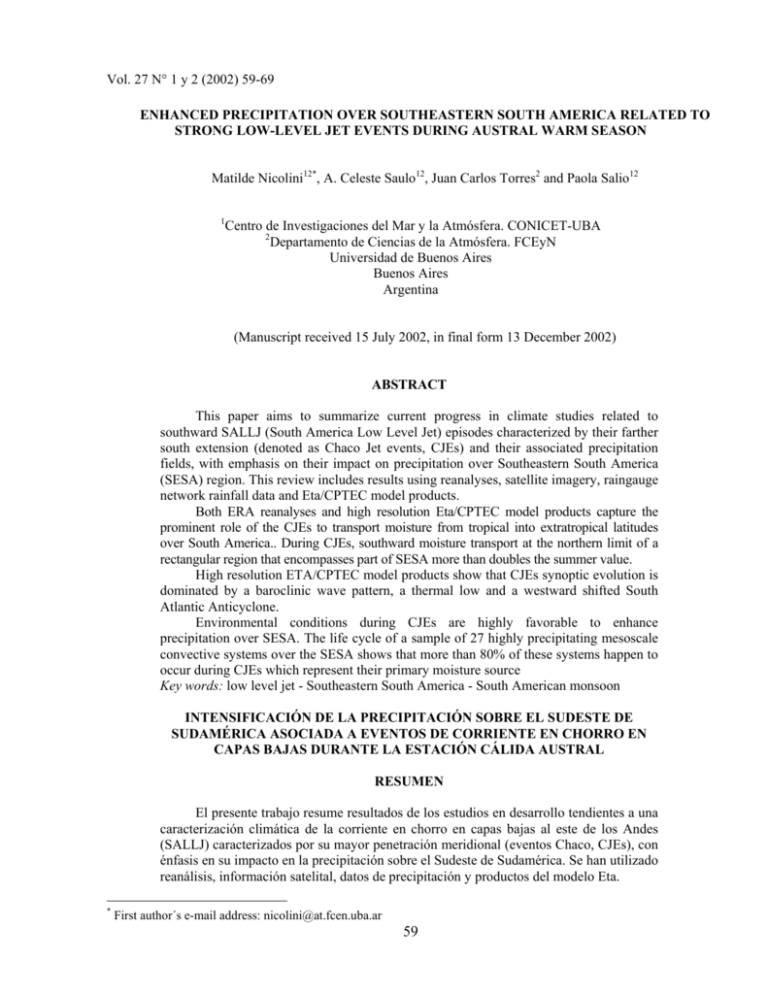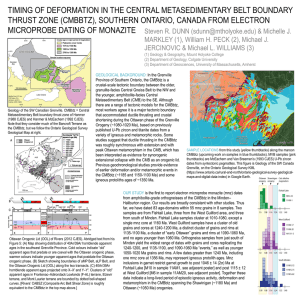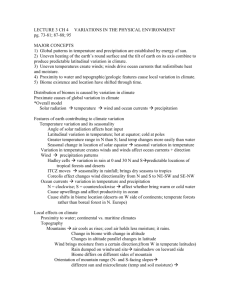ENHANCED PRECIPITATION OVER SOUTHEASTERN
advertisement

Vol. 27 N° 1 y 2 (2002) 59-69 ENHANCED PRECIPITATION OVER SOUTHEASTERN SOUTH AMERICA RELATED TO STRONG LOW-LEVEL JET EVENTS DURING AUSTRAL WARM SEASON Matilde Nicolini12*, A. Celeste Saulo12, Juan Carlos Torres2 and Paola Salio12 1 Centro de Investigaciones del Mar y la Atmósfera. CONICET-UBA 2 Departamento de Ciencias de la Atmósfera. FCEyN Universidad de Buenos Aires Buenos Aires Argentina (Manuscript received 15 July 2002, in final form 13 December 2002) ABSTRACT This paper aims to summarize current progress in climate studies related to southward SALLJ (South America Low Level Jet) episodes characterized by their farther south extension (denoted as Chaco Jet events, CJEs) and their associated precipitation fields, with emphasis on their impact on precipitation over Southeastern South America (SESA) region. This review includes results using reanalyses, satellite imagery, raingauge network rainfall data and Eta/CPTEC model products. Both ERA reanalyses and high resolution Eta/CPTEC model products capture the prominent role of the CJEs to transport moisture from tropical into extratropical latitudes over South America.. During CJEs, southward moisture transport at the northern limit of a rectangular region that encompasses part of SESA more than doubles the summer value. High resolution ETA/CPTEC model products show that CJEs synoptic evolution is dominated by a baroclinic wave pattern, a thermal low and a westward shifted South Atlantic Anticyclone. Environmental conditions during CJEs are highly favorable to enhance precipitation over SESA. The life cycle of a sample of 27 highly precipitating mesoscale convective systems over the SESA shows that more than 80% of these systems happen to occur during CJEs which represent their primary moisture source Key words: low level jet - Southeastern South America - South American monsoon INTENSIFICACIÓN DE LA PRECIPITACIÓN SOBRE EL SUDESTE DE SUDAMÉRICA ASOCIADA A EVENTOS DE CORRIENTE EN CHORRO EN CAPAS BAJAS DURANTE LA ESTACIÓN CÁLIDA AUSTRAL RESUMEN El presente trabajo resume resultados de los estudios en desarrollo tendientes a una caracterización climática de la corriente en chorro en capas bajas al este de los Andes (SALLJ) caracterizados por su mayor penetración meridional (eventos Chaco, CJEs), con énfasis en su impacto en la precipitación sobre el Sudeste de Sudamérica. Se han utilizado reanálisis, información satelital, datos de precipitación y productos del modelo Eta. * First author´s e-mail address: nicolini@at.fcen.uba.ar 59 Matilde Nicolini, C. Saulo, J. Torres and P. Salio Tanto los reanálisis ERA como el modelo Eta/CPTEC capturan el rol preponderante de los CJEs en el transporte de humedad desde los trópicos a los extratrópicos. Durante los CJEs se duplica la magnitud del transporte desde el borde norte de la región SESA respecto del verano. Ell modelo Eta/CPTEC muestra que la evolución sinóptica durante los CJEs está dominada por un patrón de ondas baroclínicas, una baja térmica y un corrimiento del Anticiclón del Atlántico hacia el continente. Las condiciones ambientales durante los CJEs son altamente favorables a la intensificación de la precipitación sobre la región SESA. Se han compuesto 27 sistemas convectivos productores de precipitaciones intensas, encontrándose que más del 80% de estos sistemas evolucionan durante CJEs, lo que confirma que estos últimos representan el aporte principal de humedad a la convección altamente precipitante. Palabras clave: Corriente en chorro en capas bajas - Monzón de Sudamérica The Chaco Jet Event criterion is similar to Bonner's criterion 1 (Bonner, 1968) and requires that: i. Maximum wind intensity (V) immediately east of the Andes at 850 hPa must be equal or greater than 12 ms-1, must originate in tropical latitudes and extend at least to 25°S. ii. Wind speed differences ranging from 850 to 700 hPa must be larger than or equal to 6 ms-1 in some part of the region comprised by the 12 ms-1 isotach. iii. The meridional component (v) must be poleward and greater than the zonal component (u) in the entire region enclosed by the 12 ms-1 isotach. This condition is established in order to exclude events that take place prior to the passage of a frontal system at 25°S where the zonal wind component is strongly predominant. 1. INTRODUCTION Low-level jets have been identified over different regions of the world. A low-level jet immediately east of the Andes (SALLJ) has been identified from observations by different authors (Fernández and Necco, 1982; Inzunza and Berri, 1990; Douglas et al., 1998; Saulo et al., 2000, Marengo et al., 2002). Despite these works, several papers and workshops have stressed the necessity to progress in this documentation and in the understanding of processes that generate and control this particular low-level jet as well as its role in the water vapor transport and as a triggering mechanism of organized convection over Southeastern South America. Previous work (Nicolini and Saulo, 2000, Salio et al., 2002) has focused in an intensification of the mutual dependency between enhanced precipitation and moisture flux convergence in the exit region of the low-level jet in continental latitudes to the east of the Andes mostly between 25ºS and 40°S. This region has been identified as the Southeastern South American (SESA) region. They hypothesize that this intensification depends on the incidence of events that penetrate farther south from the SALLJ mean maximum location near Santa Cruz de la Sierra (Bolivia, hereaftercalled STA). Accordingly, a sub-ensemble of SALLJ cases denoted as Chaco jets have been identified both during the 1997-1998 warm season (ETA/CPTEC -Centro de Previsao de Tempo e Estudos Climaticos, Brazil- model products, Nicolini and Saulo, 2000) and during 15 summer seasons (ERA -European Centre Medium Weather Forecast reanalyses- Salio et al., 2002). This paper aims to summarize current progress in studies related to climatically characterize strong southward SALLJ events and their associated precipitation fields, with emphasis on their impact on the water vapor budget over the SESA region. Distribution of regional precipitation and its variability have a mesoscale component and therefore mesoscale convective systems are important in understanding the local climate. These mesoscale systems are partially tied to surface characteristics and are in turn strongly modulated by the diurnal cycle and by transient synoptic systems. This scale interaction may lead to heavy rains and eventually flooding. Features connected with diurnal variability and highly precipitating organized convection and its dependence on CJE´s (Chaco Jet events) 60 Enhanced Precipitation Over Southeastern ... environment will be discussed. This review includes results using ERA reanalyses, ETA/CPTEC model products, satellite imagery and daily-accumulated precipitation data over the land from an extensive raingauge network in Argentina, Brazil, Paraguay and Uruguay. This work is organized as follows. Section 2 climatically characterizes the fields of vertically integrated water vapor fluxes, net moisture flux convergence over SESA and precipitation during these particular events. Some diurnal and synoptic variability features associated with CJEs from the high resolution ETA/CPTEC model products corresponding to the warm season 1997-1998 are described in section 3. A brief presentation of the dominant features in the environment of a particular sample of mesoscale convective systems mostly related to CJEs is given in section 4. Section 5 summarizes the main findings. days examined (228 summer days and 101 events verify the CJE criterion). Their duration varies from 1 to 10 days, and more frequently between 1 to 5 days. Outstanding features of the circulation and the thermodynamic field that represent this ensemble have been described by Salio et al. (2002) for this particular data set. It is of interest in this paper to focus in the aspects related to the vertically integrated water vapor flux field, net moisture flux convergence and precipitation field over SESA. Mean daily fields are calculated using the four available hours, composite fields for each variable are obtained as averages over the days that comprise each event. The anomalies are determined with respect to the corresponding averages of the 15 summer seasons of the ERA. A better recognition of singularities and intensity of these particular events may be attained comparing two separate sub-ensembles that integrate the more general SALLJ ensemble (56% of the summer days), namely the Chaco-SALLJ (CJEs) and the non-Chaco SALLJ (denoted as NCJEs, which excluding the Chaco +1 days have a frequency of 34% of the summer days). Figure 1 displays the vertically integrated water vapor flux field (Q vectors and intensity isolines) for CJEs and NCJEs respectively (Fig. 1a and 1b). More than 200 kg (ms)-1 values are observed during CJEs compared to less than 100 kg (ms)-1 during NCJEs 2. CLIMATOLOGICAL PERSPECTIVE OF CHACO JET EVENTS OVER SESA DURING SUMMER Chaco jet events represent a subensemble of low-level jet events east of the Andes. They are relatively infrequent during summer (December, January, February) as calculated with the ERA data set, since they represent only 17% of the b) a) Figure 1: Vertically integrated moisture flux (vectors, values higher than 100 m-1 s-1 are shaded) for: a) CJEs composite and b) NCJEs composite during summer, northerly values are shaded. Fields were calculated using ERA 1979-1993. 61 Matilde Nicolini, C. Saulo, J. Torres and P. Salio convergence over the South Atlantic Convergence Zone (SACZ) domain during NCJEs whereas a divergence over the SACZ area and strong moisture flux convergence over the SESA area are evident during CJEs at the leading edge of the anomalous southward penetration of the low-level jet. These two components of a Q divergence dipole are similarly located to the components of the intraseasonal meridional seesaw pattern of dry and wet conditions over tropical and subtropical South America analyzed by Nogues-Paegle and Mo (1997) after applying a completely different methodology, providing further evidence of the significance of this pattern. over northern Argentina, Paraguay and southern Brazil. Besides, this intensification is accompanied by a dominant meridional component during CJEs over a broad area whereas a more northwest to southeast direction characterizes the Q vector during NCJEs. This behavior is more evident in the anomalies in the Q vector and in its convergence (Fig. 1c and 1d) for the summer season. The anticyclonic anomalous circulation in Figure 1b is related to a deepened thermal low and a shift of the South Atlantic Anticyclone toward the continent for the CJEs composite. A comparison with the summer mean fields points to stronger Q c) d) Figure 1, cont: Vertically integrated moisture flux anomaly (vectors, values higher than 100 m-1 s-1 are shaded) for c) CJEs composite and d) NCJEs composite. Fields were calculated using ERA 1979-1993. boundary exits through the eastern boundary during summer and especially during the NCJEs while the outflow is almost equally partitioned across the eastern and southern boundaries during CJEs. Both summer and NCJEs show weak net column integrated moisture convergence over the SESA domain. During CJEs, southward transport at the northern limit more than doubles the average summer value and even if this influx is partially compensated by an outflow through the southern border the net column integrated moisture convergence over the SESA domain is strongest. This important difference both with respect to the summer mean and the NCJEs is consistent with the Figure 2 (a, b and c) depicts the net influx at the lateral boundaries of a rectangular region (20º 40ºS, 45º -64ºW) that encompasses part of SESA and a contiguous maritime area as well as the net vertically integrated moisture divergence seasonal mean, and the corresponding mean for the CJE and NCJE sub-ensemble, respectively. The strongest influx of moisture is at the northern boundary in the three samples with larger values during SALLJ events, convergent flux in the north-south direction and divergent flux in the zonal direction. Therefore the transports across the different boundaries are in the same sense for the three cases. However, much of the moisture that enters from the northern 62 Enhanced Precipitation Over Southeastern ... previous comparison in terms of Q divergence anomaly fields and reinforces the impact of CJEs on the moisture transport over SESA during the summer months. Environmental conditions during CJEs are then highly favorable to enhance precipitation over SESA. Figure 3 (a and b) shows the daily precipitation fields for the two composites (CJEs and NCJEs). Again, the pattern of wet (dry) conditions over SESA during CJEs (during NCJEs) and an opposite behavior over tropical South America (around SACZ mean position) is evident. The position of the maximum precipitation is closely associated with the occurrence of highly precipitating convective systems, as is discussed in subsequent sections. -1.90 0.43 1.61 0.05 -0.67 -3.85 0.82 1.80 -1.33 -1.54 -2.35 0.54 2.19 -0.18 -0.52 Figure 3: Observed mean daily accumulated precipitation in mm day-1 for a) CJEs and b) NCJEs. Contour interval is 1 mm day-1 and values higher than 5 mm day-1are shaded. Figure 2: Net moisture flux divergence and net moisture flux in 108 kg s-1 over the SESA region for a) the austral summer, b) the CJEs and and c) NCJEs. 63 Matilde Nicolini, C. Saulo, J. Torres and P. Salio 60°W. From this figure it can be seen that this transport maximizes during nocturnal or very early morning hours (00 UTC corresponds to 9 PM local time), confirming the key role played by the LLJ in the moisture transport at this region. It is noticeable that, if only one particular summer month is considered, (e.g. December 1997), this transport is around 90% larger than that associated to the Great Plains LLJ as calculated by Berbery et al. (1996) for an individual northern hemisphere summer month. In both cases the latitude where the corresponding LLJs are maximum has been considered. Most striking is the impact that CJEs have on this transport, with anomalies almost doubling the mean seasonal value at the selected point (Figure 4b). This same CJE related signal can be identified at different latitudes along the NW-SE transect that characterizes the maximum northerly wind current (see Figure 1). In order to illustrate the cross-current dimension of this flow, the lower panels in Figure 4 show a vertical cross section of moisture transport for the seasonal mean and also for the CJE anomalies. Again, the anomalies are concentrated over the jet area and double the moisture transport for the period. 3. DIURNAL AND SYNOPTIC VARIABILITY FEATURES RELATED TO CJES FROM ETA/CPTEC MODEL PRODUCTS The availability of high-resolution model products over this region provides a useful approach to the depiction of smaller scale characteristics that cannot be captured by global models, and consequently may not be represented by the analyses. The ETA/CPTEC model is run operationally twice a day, over a domain that covers most of South America, with a horizontal resolution of 40 km, and 35 vertical layers. During the 1997-1998 warm season, ETA/CPTEC (Centro de Previsão de Tempo e Estudos Climáticos) model outputs were analyzed to describe the mean low level circulation with emphasis in the detection of LLJ occurrence (Saulo et. al, 2000). As in the previous section, the CJE cases were also isolated for this period. In this section, emphasis will be placed in the description of both the CJE´s diurnal oscillation and in the synoptic evolution that characterize these events. The upper panels in Figure 4 show the diurnal cycle of the water vapor transport at 22°S, Figure 4: a) Time-height cross section at 22°S, 60°W of the stationary component of the 1997-1998 warm season mean meridional water vapor transport (in kg m s-1 ); b) same as a) but for the for CJE anomaly; c) Same variable as in a) but for its vertical cross-section along 22°S , shading indicates the approximate Andes mountains profile at this latitude; d) same as c) but for the for CJE anomaly. 64 Enhanced Precipitation Over Southeastern ... water transport, is not expected over the SACZ area. When the corresponding fields in ERA (not shown) and ETA cross sections are compared, both capture the same features with a quite stronger warm season mean meridional moisture transport in the higher resolution model products respect to the reanalyses. However, maximum values are more similar for the CJE composite (anomalies are stronger in the ERA CJE composite than in the ETA). Also, it can be recognized that the zonal dimension of this current is approximately 500 km, with a narrower maximum, indicating the importance of high-resolution data sets to adequately quantify this transport. Another feature of interest arising from this figure is the secondary maximum of moisture transport that appears to the east of the Brazilian Planalto in the warm season mean (figure 4c). This maximum is not present in the anomaly field, suggesting that when the LLJ has a stronger southward penetration, weaker activity, in terms of Figure 5: CJE´s mean temporal evolution. Upper panels- shaded: mean sea level pressure change (in hPa) from day -2 to -1 (left), from day -1 to 0 (middle) and from day 0 to +1; contours: mean sea level pressure (in hPa) at day -1 (left), at day 0 (middle) and at day +1 (right). Middle panels: same as upper panels but for 500 hPa geopotential heights (in m). Lower panels: same as upper panels but for 500/1000 thickness fields (in m). 65 Vol. 27 N° 1 y 2 (2002) 1-11 intermittent nature that is observed over this region (Lichtenstein, 1980). While there are still many aspects that should be further explored, our hypothesis is that the NAL formation precedes that of the CJE, providing a geostrophic forcing that helps to organize the low level wind into a meridionally enlarged low level current that starts around 15°S and reaches latitudes southward of 35°S. This well organized northerly current is one of the clearest manifestations of tropical-extratropical mass exchange in the continent. Recent work (Seluchi et al, 2002) shows that this low pressure system is strongly driven by surface heating, which is favored by clear skies, characteristic of the preCJEs environment. Nevertheless, it is also evident that the baroclinic component plays a nonnegligible role on NAL deepening, providing the upper-level adequate environment to favour surface cyclone strengthening. Even if this comparison is not rigorous as ERA covers 15 warm seasons whereas ETA corresponds to only one, this result reveals a more synoptic signal and in turn a pattern that is less dependent on model or analysis resolution. Consistent with Figure 1, the corresponding field in ERA NCJE composites at the latitude of maximum meridional water vapor transport (17ºS) also displays the same feature in the SALLJ domain but with smaller magnitudes. The synoptic evolution that characterizes CJEs can be introduced with the aid of Figure 5. This figure has been extracted from Nicolini and Saulo (work in progress) and shows composite tendencies from day -2 to day +1, where day 0 corresponds to the CJE ensemble mean. Following mean sea level pressure tendencies (Figure 5 upper panels), a clear negative pressure change is evident, that is stronger from day -1 to day 0 and reverses its sign the following day, denoting the signature of a frontal passage. The position of this negative pressure center leads that seen at 500 hPa (middle panels), indicating the baroclinic component in CJEs environment. There is a clear wave pattern with spatial length and time evolution that are characteristic of midlatitude synoptic perturbations. Another distinguishing aspect of these composites is the warm core that appears over Argentina 2 days before, and reinforces subsequently (lower panels). This feature is typical of the Northwestern Argentina Low (NAL), a thermal-orographic low-pressure system of 4. RELATIONSHIP BETWEEN MESOSCALE CONVECTIVE ORGANIZATION AND SALLJ EVENTS. Previous studies found that a strong lowlevel jet is a recurrent feature of the environment during initiation and maximum extent of mesoscale convective complexes (MCCs), although they are not present during the dissipation stage over the Great Plains of the United States (Maddox, 1983). 30 MCCs over USA (cloud shield) MCCs over USA (cloud shield) 25 20 MCCs over South America MCCs over S. A. (cloud shield) (cloud shield) 15 MCSs over S. A. (active cores) MCSs over South America (active cores) 10 5 0 0 -1 1.1-2 2.1 3 3.1-4 4.1 - 5 5.1 - 6 6.1-7 7.1-8 8.1-9 9.1-10 10.1-11 11.1-12 12.1-13 13.1-14 Figure 6: Frequency distribution (ordinates) of areas for MCSs over South America and MCCs over South America and over USA. Cloud shield curves for MCCs follow Velasco and Fritsch (1987). Abscissas denote areas in 1×105 km2 This issue was also addressed for the South American counterpart, not restricting the study to MCCs, but considering a more general ensemble of mesoscale convective systems (MCSs). 66 Enhanced Precipitation Over Southeastern ... A similar methodology was followed for compositing the environmental conditions corresponding to 27 highly precipitating mesoscale convective systems (HPMCS) that occurred during the period October to April 1988/1993 over the SESA region, previously selected with a criterion based in daily precipitation amount exceeding 120 mm in at least one raingauge station within the region. Mesoscale systems and their life cycle have been recognized using the International Satellite Cloud Climatology Project (ISSCP) ISCCP-DX data, which have spatial resolution of 30 km and time resolution of 3 hours. The areal superposition method (Machado et al., 1998) has been used to track the areas encircled by the 218 K cloud top isotherm corresponding to a particular MCS, and a size and duration criteria for those areas have been used to identify an MCS through three different life stages: initial, mature and dissipation. the E, SE or NE, the southernmost at 40ºS and remain clearly continental. They attain maturity during night, with a second peak in the evening, and dissipate around noon; with an average duration of around 17 hours. These characteristics are similar to those presented by Velasco and Fritsch (1987) for the November through April periods of 1981-1982 and 1982-1983. More detailed analysis will be forthcoming in future studies by Torres and Nicolini. Figure 6 depicts the frequency distribution of areal coverage at the mature stage both, for the present sample and for the Velasco and Fritsch (1987) MCC ensembles. Taking into account that the present study uses a coldest temperature threshold (218º K) for the cold cloud shield area compared to other authors, there is a dramatic difference in size. Southeastern South America HPMCSs have huge convective cores during mature stage (average area around 5×105 km2, which represents a radius of around 400 km). In fact, using a similar infrared temperature Cotton et al. (1989) obtained an equivalent radius of 243 km for US MCCs. 100 200 300 Initiation Pressure (hPa) 400 500 600 700 Maturity 800 Dissipation 900 1000 0 3 6 9 12 15 Wind speed (m s-1) Figure 7: Vertical prof. of wind speed over grid points where speed is maximum at 925 hPa in each stage. Figure 8: Wind vector and isotachs (m s-1) at 24º S during mature stage. These systems initiate during the afternoon to the east of the Andes, follow a trajectory toward 67 Matilde Nicolini, C. Saulo, J. Torres and P. Salio mean geopotential field at low levels, dominated by a thermal low and a shifted toward the continent South Atlantic Anticyclone, enhance a frontogenetical pattern that finally evolves in a frontal passage that marks the demise of the CJE. These characteristics are similar to those described by Garreaud and Wallace (1998) during the day before the onset of an equatorward incursion of midlatitude air into subtropical South America during summer. Midlevel geopotential anomaly fields for CJEs show a wave pattern similar to the one obtained in the Garreaud and Wallace (1998) composite for their day –1.5. For this day they found a stronger than normal low-level northerly flow and an area of enhanced convection over SESA. This convective area is not still organized in a band and its leading continental part is collocated with the CJE´s composited precipitation core for the 15 summers. Seasonal precipitation features have been analyzed recently by Nesbitt and Zipzer (2002), over South America from TRMM satellite data. In particular, they identified MCSs over subtropical South America and found a morning peak in MCS rainfall due to a small number of very large MCSs that contribute more than 80% to total precipitation with maximum occurrence in an area collocated with the one found in the present paper. Also, Nieto Ferreira et al. (2002) in a comparison of convective systems during the summers 1998 and 1999 and using a similar temperature threshold to define the coldest portion of the MCSs using infrared imagery, localized more numerous and larger MCSs during summer 98 (El Niño) than summer 99 (La Niña) over the same mentioned area within the SESA region. This result is consistent with the high occurrence of CJEs during the 97-98 warm season (31%). The agreement in the location of heavy precipitation systems and in their intensity obtained from different periods and data sets give confidence to the results and emphasize the relevance of CJEs in the precipitation over SESA. In particular, given the high amount of summer precipitation that is explained by MCS and consequently by CJEs, these should also be stressed as key features of South American climate. Yet, much work is still needed to understand how different scale forcings combine to cause these particular LLJs. Screening of ERA fields for the MCSs sample to test the Chaco jet criteria, reveals that more than 80% MCSs occur during these events. Therefore, environmental conditions during these situations promote organized convection and heavy rainfall in the SESA region. Accordingly, a northerly low-level jet (Figures 7 and 8) and related maximum of moisture flux convergence (Figure 9), that intensifies and expands towards the northwest and into the MCS region during its lifetime, represents its primary moisture source. Figure 9: Analysis of 925 hPa at the mature stage: temperature (dashed lines, ºC), specific humidity (solid lines, g kg-1) and moisture flux convergence (shaded, ≤ 1×10-7 s-1). The cross (+) indicates the average position of the MCSs at the mature stage. 5. CONCLUDING REMARKS Both ERA reanalyses and high resolution ETA/CPTEC model products capture the prominent role of the CJEs to transport moisture from tropical into extratropical latitudes over South America. A comparison between CJEs and NCJEs show that the latter are more frequent, pushing the mean summer behavior toward the NCJEs while the former present a stronger baroclinic component in the synoptic scale and are less frequent. The 68 Enhanced Precipitation Over Southeastern ... Lichtenstein, E.R., 1980. The Northwestern Argentina Depression (in Spanish). PhD Dissertation, University of Buenos Aires, Argentina, 223 pp. Machado, L. A. T., W. B. Rossow, R. L. Guedes and A. W. Walker, 1998. Life cycle variations of mesoscale convective systems over the Americas. Mon. Wea. Rev., 126, 1630-1654. Maddox, R. A., 1983. Large-scale meteorological conditions associated with midlatitude, mesoscale convective complexes. Mon. Wea. Rev., 111, 1475-1493. Marengo, J. Douglas, M. and P. Dias, 2002. Towards an identification of the South American low-level jet east of the Andes during the LBATRMM and LBA-WET AMC campaign of the summer of 1999. In press in J. Geophys Research. Nesbitt, S. W. and E. J. Zipser, 2002: The diurnal cycle of rainfall and convective intensity according to three years of TRMM Measurements, Submitted to J. Climate. Nicolini, M. and A. C. Saulo, 2000. Eta characterization of the 1997-1998 warm season Chaco jet cases. Preprints 6th International Conference on Southern Hemisphere Meteorology and Oceanography, Chile, 330-331. Nieto Ferreira , R., T. M. Rickenbach, D.L. Herdies, and L.M.V. Carvalho, 2002: Variability of South American convective cloud systems and tropospheric circulation during January-March 1998 and 1999. Accepted for publication in Mon. Wea. Rev. Nogués-Paegle. J. and K.-C. Mo, 1997. Alternating wet and dry conditions over South America during summer. Mon. Wea. Rev., 125, 279-291. Salio, P. V., M. Nicolini and C. Saulo, 2002. Chaco low level jet characterization during the austral summer season by ERA reanalysis. In press in J. Geophys. Res.-Atmospheres. Saulo, C., M. Nicolini, and S. C. Chou, 2000. Model characterization of the South American lowlevel flow during the 1997-98 spring-summer season. Climate Dynamics,16, 867-881. Seluchi, M., Saulo, C.A., Nicolini, M. and P. Satyamurti, 2002. The Northwestern Argentinean Low: a study of two typical events. Submitted to Monthly Weather Review. Velasco, I. y J.M. Fritsch, 1987. Mesoscale convective complexes in the Americas. J. Geoph. Res., 92, 9591-9613. Acknowledgements. We thank the Servicio Meteorológico Nacional (Argentina), the Dirección Nacional de Meteorología e Hidrología (DINAC, Paraguay), the Dirección Nacional de Meteorología (Uruguay), the Agencia Nacional de Energía Eléctrica (Brazil) for providing the observed precipitation data set. We are grateful to the NASA Langley Research Center for providing the ISCCPDX data and to the Centro de Previsão de Tempo e Estudos Climáticos (CPTEC) for the ETA/CPTEC model products, and for the provision of the ERA reanalyses data under the LBA project (Large Scale Biosphere-Atmosphere Experiment in Amazonia) used in this research. This research was partially supported by ANPCYT through Projects PICT 071757 and 07-06671, by Univ. de Buenos Aires through Projects TX30 and X055, by IAI through Project PROSUR-CRN 055 and by CONICET through project PIP 4520/96 and a PhD scholarship to Paola Salio. REFERENCES Berbery, E. H., E. M. Rasmusson and K. E. Mitchell, 1996: Studies of North American continental-scale hydrology using Eta model forecast products, J. Geophys. Res., 101, D3, 73057319. Bonner, W. D., 1968: Climatology of the low level jet, Mon. Wea. Rev., 96, 833-850. Cotton, W. R.; M. S. Lin; R. L. McAnelly and C. J. Tremback, 1989. A composite model of mesoscale convective complexes. Mon. Wea. Rev., 117, 765-783. Douglas, M., W., M. Nicolini, and C. Saulo, 1998. Observational evidences of a low level jet east of the Andes during January-March 1998, Meteorologica, 23, 63-72. Fernandez A. and G. Necco, 1982. Wind field characteristics in the free atmosphere at Argentinean upper-air stations (in Spanish). Meteorologica, 13, 2, 7-21. Garreaud, R. D. & Wallace J. M., 1998. Summertime incursions of midlatitude air into subtropical and tropical South America. Mon. Wea. Rev., 126, 2713-2733. Inzunza, B. J. and G. J. Berri, 1990. Wind and water vapor transport in the low troposphere over northern Argentina (in Spanish). Meteorologica, 17, 17-25. 69








